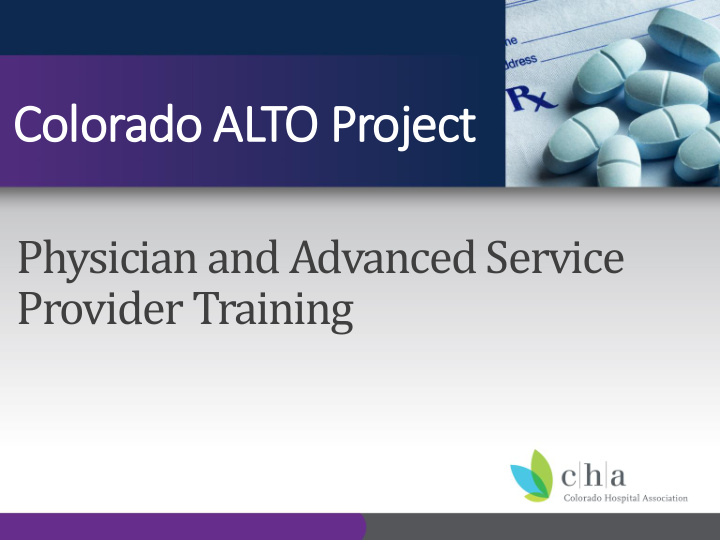



Colorado ALTO Project Physician and Advanced Service Provider Training
Provider Training Learning Objectives • Discuss the historical context and current state of the "opioid crisis" facing the United States, and identify barriers to change • Describe the appropriate use of alternatives to opioids for treatment of different types of pain in the ED • Review the implementation of an opioid-reduction process and policy
Provider Training Goals GOAL 1: Master the CO-ACEP guidelines Goal 2 : Develop a strategy for implementation in your ED GOAL 3: Identify barriers GOAL 4: Change your culture; join the Colorado ALTO movement
Goal 1: Master the CO-ACEP Guidelines 4 Pillars of Care
Limiting Opioids from the ED • Know our prescribing practices • Remove preselected opioids from order sets • Stop wanting to prescribe them … fight the impulse, fight your own addiction.
ALTO Principles 1. Non-opioid medications first 2. Opioids as rescue therapy and not used liberally 3. Multimodal and holistic pain management 4. Specific pathways exist Kidney stones • Low back pain • Fractures • Headache • Chronic abdominal pain • 5. Requires more patient engagement: Discuss realistic pain management goals with • patients Discuss addiction potential and side effects with • using opioids
ALTO and CERTA – Putting Science Back In Pain Control
Lidocaine • Acts on central and peripheral voltage dependent sodium channels, G protein- coupled receptors and NMDA receptors • Used topically , intravenously or as trigger point injections o When used at low doses, IV lidocaine is generally benign o Caution should be used when giving IV to patients with a severe cardiac history • MSK, migraines, renal colic, abdominal, neuropathic • Lidocaine patches are great for pain! • Lidocaine IV doses ≤ 1.5 mg/kg over 10 - 60 min may be given in non-ICU areas (max 200 mg/dose)
Ketamine • NMDA receptor antagonist • When used at low doses, it is generally benign • Used intranasally or intravenously • Should not be used in patients with PTSD
Ketamine • Ketamine effect is dose-dependent • May be used for analgesia at doses ≤ 0.2 mg/kg via slow IVP or 0.1 mg/kg/hr infusion o May be given in non-ICU areas o Slow administration rate (≥ 10 min) = less adverse effects • Ketamine 50 mg IN can also be given o No IV access • Can be used adjunctively with opioids to reduce opioid requirements
Other Options • Ketorolac o 15 mg for everyone (IV or IM) • No difference in pain reduction with 30 vs. 15 mg o Great for many pain indications including musculoskeletal pain and renal colic • Haloperidol o Low dose (2.5-5 mg IV) o Great for nausea • Cannabinoid induced hyperemesis
Other Options • Dicyclomine o Antispasmodic and anticholinergic agent that acts to alleviate smooth muscle spasms in the GI tract o 20 mg PO/IM (NOT IV!) o Great for abdominal pain o Caution in elderly Photo source: MedicaLook
Other Options Metoclopramide/Sumatriptan/Dexamethasone • For headache Gabapentin/Valproate • 5HT1-4 and GABA receptors modulate pain in the spinal cord DDAVP • Synthetic vasopression – some evidence of relief of renal colic Nitrous Oxide • Safe, short acting • Use for painful procedures, decreases opioid usage NSAIDs and APAP
Trigger Point Injections Indications: • Myofascial Pain Syndrome • Headaches - tension and migraines • Musculoskeletal back pain • Torticollis . . • Trapezius strain . . Concerns: . . • Infection . . • Hematoma • Arterial injection (Bupivacaine) • PTX on chest
Goal 2: Develop Strategies for Implementation in Your ED 1. Support by your administration and medical director: this is one of your top goals for 2018. 2. Group buy in – email / communications. 3. ED physician meetings – schedule your training, establish your culture. 4. Submit and use the data – take advantage of what CHA is offering and the Hawthorne Effect. 5. Keep at it – systematic change is an endurance sport.
Goal 3: Obstacles to Implementation: If The Policy Don’t Work…Change the Policy. Procedural sedation vs. pain dose Ketamine • Scope of practice Nerve blocks • Fascia iliaca blocks • Trigger point injections • High-risk medication administration Lidocaine administration • Ketamine • Nitrous oxide •
Goal 4: Change Your Culture; Join The Colorado ALTO Movement By joining the Colorado ALTO Project you are joining a movement. • Colorado Hospital Association is with you. • Hospital administration is with you. • Nurses are with you. • Pharmacy is with you. • History and science are with you.
Data Collection • Metrics o # of ED opioid administrations o Measured in morphine equivalent units/1000 ED visits • # of ED ALTO administrations • Data source EHR and administrative data o • Optional metric o Ratio of opioids administered to ALTOs administered/physician
Partners
Questions? Resources www.cha.com/ALTO Provider Contact Information Don Stader, MD, FACEP Colorado ALTO Project Physician Champion donald.stader@gmail.com
Thank you for joining the Colorado ALTO Project.
Recommend
More recommend